We all know Fury Road is great, but perhaps you need some convincing that the original Mad Max trilogy is worth your time. Perhaps you missed Beyond Thunderdome each of the many times it was shown on a cable outlet, and are now leery of Tina Turner in a fright wig. Perhaps you think moviemakers couldn’t create a believable post-apocalyptic landscape in the (mostly) CGI-free days of the 1980s. Perhaps you just can’t with Mel Gibson. I understand. (Truly! Especially about that last one.) But I’m here to show you that the original Mad Max trilogy holds many wonders.
There will be people who tell you that the first film is crap, or that the last film is crap. Those people are wrong. The original Mad Max does indeed have long boring stretches, but those patches are interrupted by some of the best chase sequences in all moviedom. And yes, Beyond Thunderdome is…well… silly. Deeply silly. But it’s also fun, and the first half in particular has some of the best post-apocalyptic worldbuilding I’ve ever seen. Which leads us to the first reason you should watch it:
It’s Not Just Another Post-Apocalyptic Wasteland
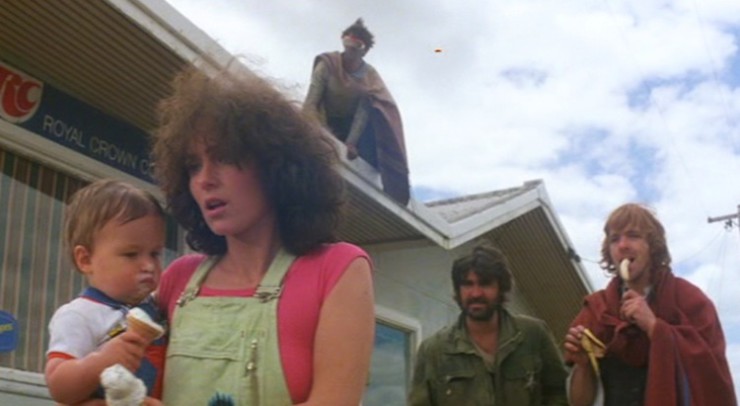 In fact, the beginning of the trilogy takes place in a pre-apocalyptic wasteland. One of the most unique things about the Mad Max trilogy is the way it shows the full arc of an apocalyptic event. In the first film society is definitely on the decline following a major energy crisis, but it does still exist in recognizable ways: there are highways, towns, ice cream shops, and enough of an infrastructure to keep things hobbling along.
In fact, the beginning of the trilogy takes place in a pre-apocalyptic wasteland. One of the most unique things about the Mad Max trilogy is the way it shows the full arc of an apocalyptic event. In the first film society is definitely on the decline following a major energy crisis, but it does still exist in recognizable ways: there are highways, towns, ice cream shops, and enough of an infrastructure to keep things hobbling along.
Mad Max initially works as a cop (note: Max is a civil servant, not a vigilante or even a military enforcer) trying to keep the roads clear of gasoline-siphoning biker gangs. By Road Warrior, the lawlessness of the gangs has become the norm, and Max, now a lone drifter, ends up helping a small community who were lucky enough to find an oil refinery—but unlucky enough to be targeted by a terrifying gang leader named The Humongous. Finally, in the third film, we learn that the nuclear apocalypse has actually occurred—Sydney’s gone, and presumably most other cities have been reduced to radioactive ash. The only people who have survived are the ones who were further out in the country, and now it’s up to them to figure out if things are even worth rebuilding.
It’s Pretty Much the Best Post-Apocalyptic Wasteland!
As other, more mainstream filmmakers were batting around the idea of the apocalypse with utter seriousness (Wargames), utter nihilism (A Boy and His Dog), or utter faith (A Thief in the Night) George Miller was making a snarky, explosive, and somehow totally realistic trilogy about humanity’s slide into a dystopian wasteland. Mad max also stands apart from all of these scenarios by focusing on the thing I think is actually going to kill us: the utter breakdown of society in the face of resource depletion.
George Miller’s Stellar Naming Conventions
Here’s a short list of the characters you will encounter in the Mad Max Trilogy: MasterBlaster, Aunty Entity, Goose, Toecutter, Feral Kid, Jedidiah the Pilot, Scrooloos, The Humoungus, Mr. Skyfish, Slake’m Thirst, and Pappagallo. The vast majority of these characters live up to the awesomeness of their names. Feral Kid is obviously the best. I mean, look at him.
Bondage Gear!
Perhaps you’ve heard about the bondage gear? Maybe even a little freaked out by it? I would argue that in addition to being visually striking, it’s also meant to be silly and impractical—a constant joke puncturing the seriousness of Apocalypse Times. It also links all of the characters; how is skintight-leather-clad Max truly any different from The Humungous? The Refinery tribe wears crazy feathers in their hair, the gyrocaptain wears canary yellow skinny jeans, and Aunty Entity wears a chainmail disco dress. Everyone looks equally ridiculous, without any simplistic telegraphing through clothes.
The Violence is Explodey But Not Gratuitous
Yes, there is a moment in Mad Max that literally inspired the entire Saw series. There is also rape, torture, and dog-murder. So what I’m about to say will seem weird, and possibly wrong-headed, but I would actually argue that the Mad Max films as a whole are not gratuitously violent. There is no tortureporn-style lingering over details, or reveling in human pain, or straight-up nihilism, as there is in, say, A Boy and His Dog. Most of the truly horrific moments either occur off-screen, or are dealt with in a way that gives emotional weight to people’s suffering.
The most violent sequence in the trilogy is the Thunderdome fight, but even then the action is directed against our nigh-indestructible hero, and the whole thing winds up pretty cartoonish. And the two times Max is actually meant to be gratuitously violent are far more complicated than they usually are in action films—these are moments when the character is very clearly pushed over the edge. Max is not the type of hero who punches his way out of problems. In fact, Max isn’t really a hero at all.
Max isn’t Actually A Hero
It turns out Tina Turner is not being rhetorical. You can read Max in a bunch of different ways, but one of the best things about the character is that he doesn’t adhere to any particular heroic arc. Sometimes he’s a lone mercenary, just out for himself. Sometimes he’s a Shane-like protector. Other times he’s a Jesus-esque sacrificial figure. And sometimes he’s just a pawn in other characters’ games.
Over the course of the trilogy Miller plays with several different heroic tropes, allowing us to see Max as lonely human in need of redemption, while also keeping him cynical enough—and smart enough—to hold other people at arm’s length. In The Road Warrior, the leader of the Refinery Tribe calls Max out for his self-pity, reminding him that everyone has suffered, and in Thunderdome he never quite becomes the messiah some of the kids want him to be. By using the character to question what makes a hero, Miller allows the films to slip between different genres and tones rather than just being slavishly “Western” or “Sci-Fi.”
Awesome Women!
There is, as I mentioned, lots of violence and a few moments of straight-up brutality aimed at women in the Mad Max trilogy. But there are also several important female warriors who protect the Refinery Tribe in The Road Warrior, and who hold their own against The Humungous’ gang. And in Beyond Thunderdome we get two different female leaders: Aunty Entity, the founder of Bartertown, and Savannah Nix, the young woman who wants to lead a group of plane crash survivors to a better home. Both of the women are real characters; rather than being noble cardboard cutouts, they make mistakes—and have to pay for those mistakes. But they’re also accepted as leaders by everyone around them, without having to fight any tired sexist battles to prove themselves.
Background Worldbuilding
When Max is discovered by the young plane crash survivors, we learn that Cusha (second from the right in the picture above) is “ready to pop.” That’s because these kids formed a post-apocalyptic community together, survived, hit puberty, and… figured stuff out. The film doesn’t dwell on this, Max doesn’t dwell on this, it’s just there in the background. It shows that humans can adapt and survive no matter what, and that’s kind of great.
You’ll Increase Your Reference Quotient At Least 1000%!
- Who Run Bartertown?
- What happens when you bust a deal?
- Should you just walk away?
- Are there any alternate definitions of the word “gulag” I should know about?
You’ll be able to answer these questions, and so many more! These films inspired the Saw series, Fallout, a whole slew of lesser imitations, and helped gain attention for the more self-consciously artistic branches of the Australian New Wave. It also gave us Mel Gibson! A mixed bag, perhaps, but… he was great in Gallipoli? But best of all, this MST3K skit will be even funnier.
It’s Actually Pretty Optimistic!
By centering us on Max and his fellow civilian survivors, Miller allows us to experience the apocalypse the way most of us actually would. We’re not in secret meetings in the War Room. We’re not the phone phreakers who inadvertently triggered Global Thermonuclear War. We’re not pilots trying to decide whether or not this is a drill. We get to watch humans like us who try to create communities together and build a better tomorrow. Granted, some people just want to watch the matches at the Thunderdome all day, but some people become gyrocopter pilots, some people build whole towns that run on a certain type of justice, and some people become reluctant messiahs. As Aunty Entity says, “On the day after, I was still alive. This nobody had a chance to be somebody.”
This article was originally published in May 2015.
Leah Schnelbach hopes that if the apocalypse does come, someone will trade food for thinkpieces carved into tree trunks. Until then, she’ll use Twitter!










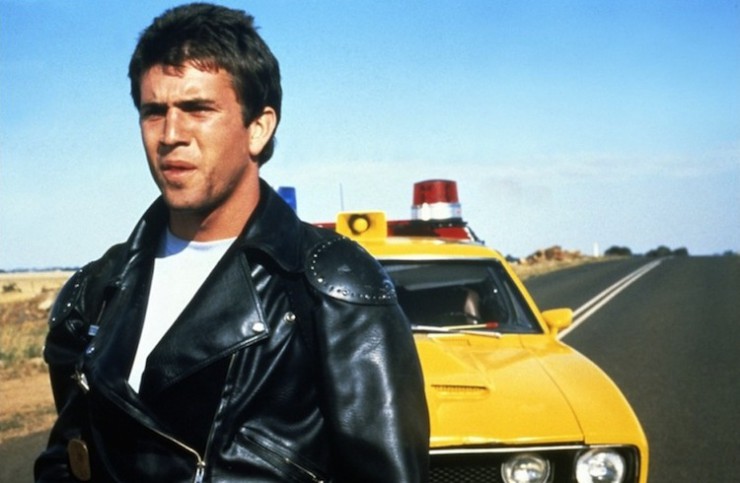
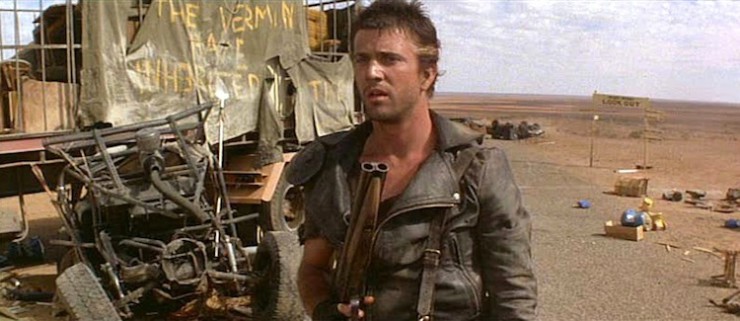
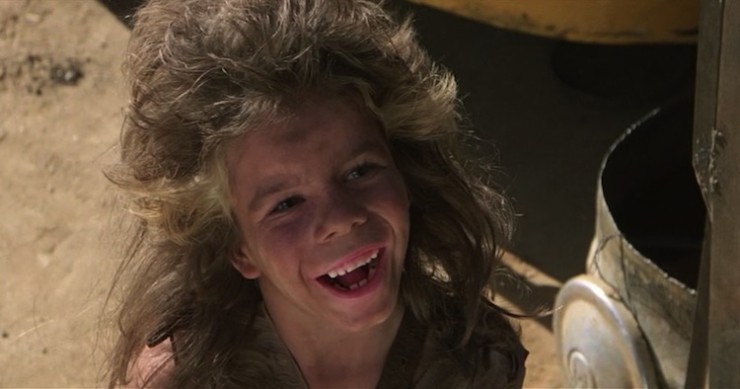
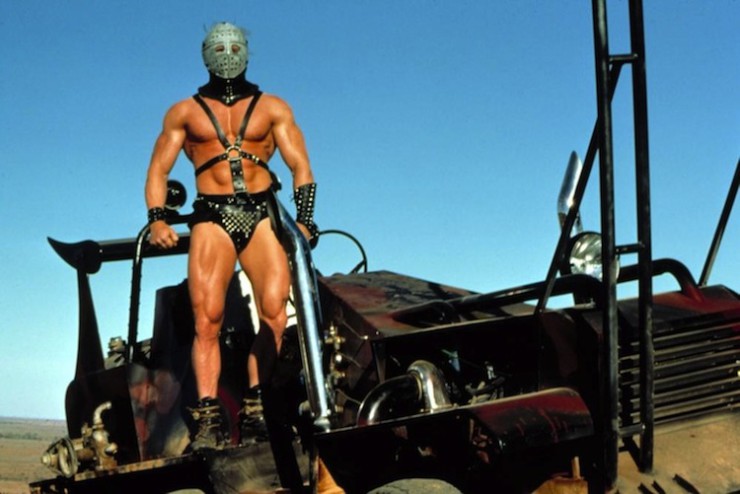
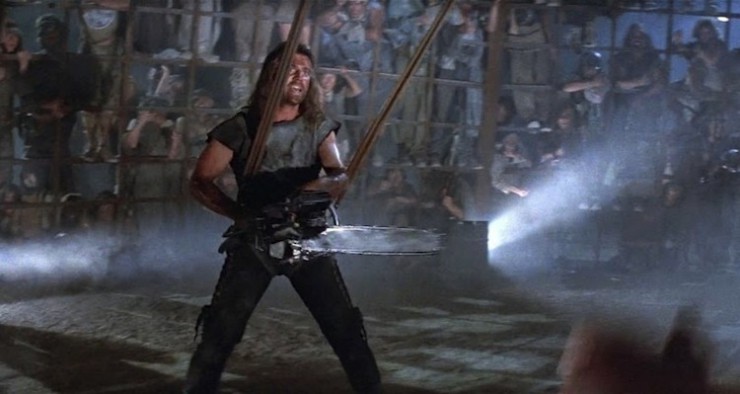
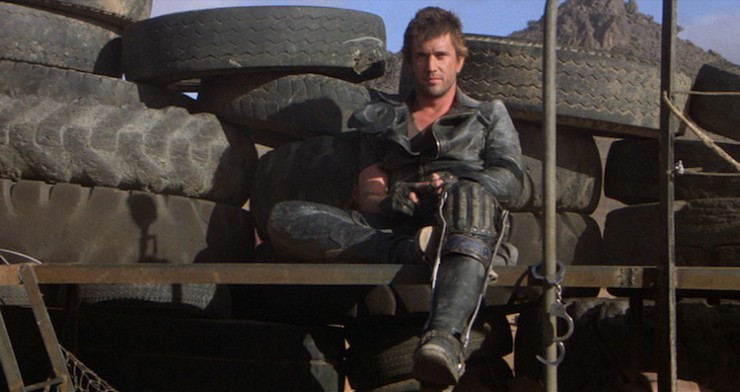
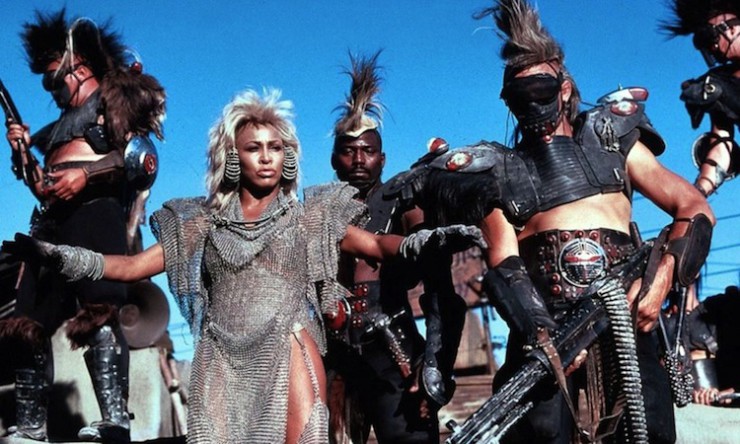
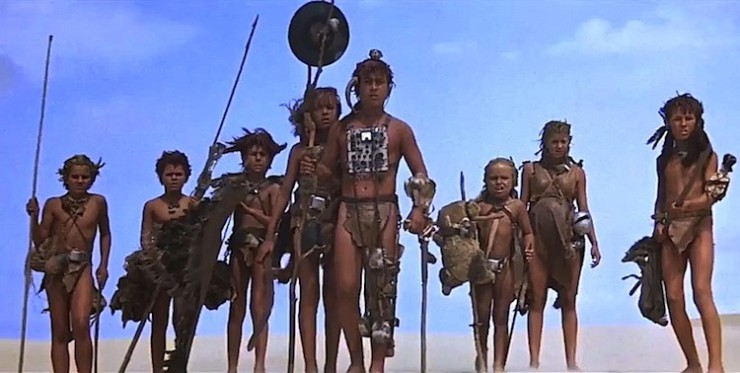
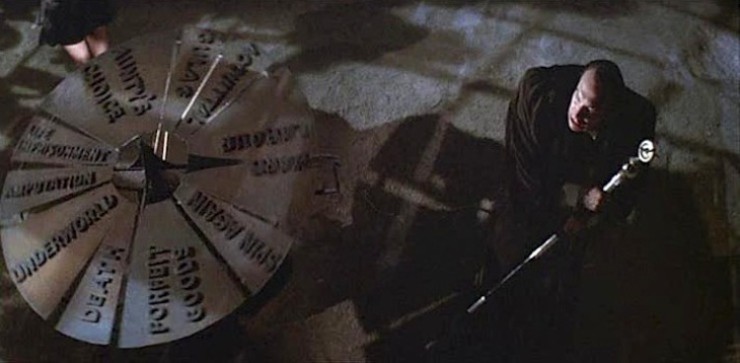
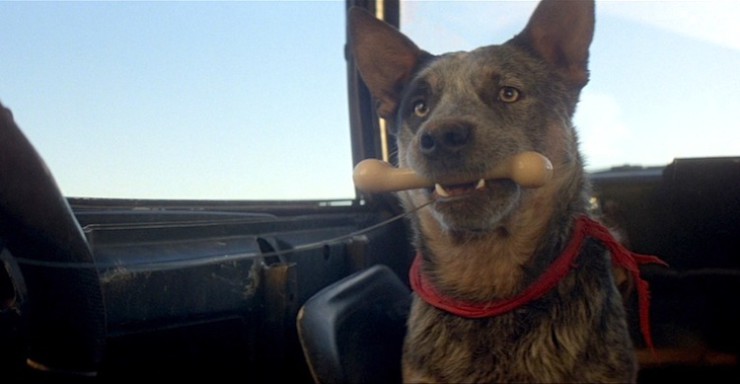
That’s two impossible things for the 1980s. Unless you didn’t have TBS I guess.
See you later, you crazy mutant desert guys.
My high school motorhead buddies and I watched the Mad Max Trilogies religiously. Kinda figured we’d thrive in that environment. (I’d like to note that Road Warrior was released in USA before Mad Max was which kinda mixed things up for us.)
I even kinda took Aunt Eninty’s “On the day after, I was still alive. This nobody had a chance to be somebody.” as my life plan..However it hit me a few years ago, that I’ve now gotten too old to pull that off.. It will be my luck that the apocalypse will happen in the next 10 years, and I really be screwed. ;)
@2: Kinda perplexed by your statement that The Road Warrior was released in the US before Mad Max. MM may have had a blink-and-you’ll-miss-it run at your local drive in, but it definitely played here first (with American voice actors dubbing over Gibson and company’s Aussie accents).
3, at the time, Mad Max’s release in the US had been so minimal that releasing the Road Warrior as a sequel was considered less desirable than presenting it on its own.
If only they’d done the same with Leonards I through IV.
“Perhaps you just can’t with Mel Gibson.”
I just do NOT get this kind of thinking.
Way back in the 70’s I stood looking at Leonardo da Vinci’s great Mona Lisa in the louver. I once watched Tiger Woods stand over and make a must make putt of 60+ feet with the tournament on the line. I once watched Elton John in concert banging away on his piano and feeling his music touch me. I once closed the last page of Tolkien’s Lord of the Rings book for the first time.
Not once in all those wonderful moments did it cross mind to question the character of the people giving me such great human artistry.
5, it might not have come to your mind, or the minds of lots of others, but then, something can just hit a person right where their heart is, and that’s what is going on. Well, not their literal heart, of course.
@6. It’s sad that these days Gibson’s drunken bigoted rant, and crazy behavior seems almost quaint. At least when compared to all the stuff coming out about other actors. I’m not really trying to defend him, since he is basically ruined for me to, but in his case I honestly think he is mentally ill. That sort of thing just gets worse with age. It’s actually pretty sad.
Question: Why watch the original Mad Max trilogy?
Answer: Because they’re f#*@ing awesome…
Toecutter is actually an Australian slang term. It’s not a name Miller made up for the film, it’s a job title: if you’re a toecutter, you are a criminal who extorts money from other criminals through threats of (or acts of) violence and torture. Also known as a “standover man”.
Beyond Thunderdome is my favorite of the series. There’s a lot of violence, but it also has a lot of weird, quirky humor. Besides that, I liked watching the remnants of our civilization slide away into half-remembered myth. The ringmaster at the Thunderdome is old enough to remember the past clearly, and he fashions his entire persona around that of a game show host. An ordinary guy in Bartertown walks along humming and whistling what he remembers of classical music. And the young people left at the oasis are in even more advanced stages of this condition since all the older people who remembered the past civilization had gone away, leaving only the faint memories of those who must have been children when disaster struck. I like that they have cave paintings to tell their history, but the storyteller uses a wooden frame that vaguely resembles the outline of a TV to focus attention on each section as the tale is told. Their interpretations of the Viewmaster slides is creative and funny, as well as the moment when they discover that the mysterious important disc that they know should speak to them when it spins turns out to just be a language tutorial.
Fury Road was not great, it was absolute trash, and so were the original films. To think otherwise shows a lack.of taste and discernment.